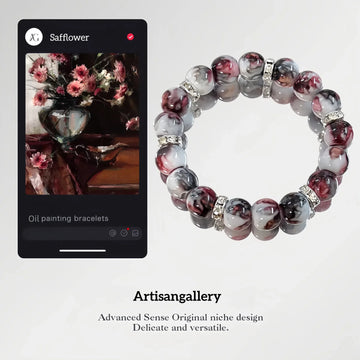When wearing stone bracelets for exercise and fitness, the following protective measures can be taken:
Choose the appropriate sports occasion: In intense sports or situations where collisions may occur, such as basketball, badminton and other competitive sports, it is recommended to temporarily remove the stone bracelet to avoid damage to the bracelet or injury to the wrist due to collisions. If the intensity of the exercise is relatively low, such as yoga or walking, you can decide whether to wear it based on your personal comfort level.
Adjust the wearing method: Make sure the bracelet fits the wrist well but not too tightly to avoid restricting blood circulation or causing wrist swelling due to excessive tightness. If the bracelet is not of the right size, you may consider taking it off temporarily and wearing it again after the exercise is over.
Avoid sweat erosion: When exercising, the human body sweats. The salt and acidic or alkaline substances in the sweat may have a corrosive effect on the stone bracelet, causing the surface to lose its luster. After exercising, the bracelet should be wiped with a soft cloth in time to remove sweat and dirt, and then stored in a dry and well-ventilated place.
Prevent physical damage: Stone bracelets may be damaged due to collision or friction, especially those that are soft or prone to wear and tear. When exercising, try to avoid your bracelet coming into contact with other hard objects, such as fitness equipment or the ground. If the bracelet has sharp edges and corners, extra care should be taken to prevent it from scratching the skin.
Pay attention to skin reactions: Certain metal components or stone materials may cause skin allergies or discomfort, especially when sweating profusely. If symptoms such as skin redness, swelling and itching occur during exercise, stop wearing it immediately and clean the skin.
Arrange the wearing time reasonably: Wearing stone bracelets for a long time may affect the blood circulation of the wrist or cause skin discomfort. It is recommended to assess the comfort of the bracelet before exercising. If you feel uncomfortable, you should adjust or remove it in time.
Avoid high-temperature environments: Some stones may undergo internal structural changes at high temperatures, affecting their texture and color. If you exercise in a high-temperature environment, such as outdoor running in summer, you should try to minimize the exposure time of your bracelet and avoid direct sunlight.
Regularly check the condition of the bracelet: After exercising, inspect the bracelet for any cracks, looseness or other signs of damage. If any problem is found, it should be repaired in time or the wearing should be suspended to avoid further damage.







